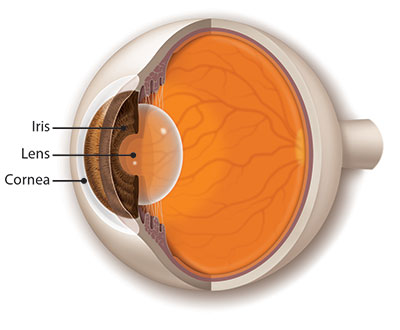What Is Corneal Cross-Linking (CXL)?
CXL is surgery to treat a weakened or warped cornea. Disease or sometimes surgery can harm collagen, an important substance that holds the cornea together. By “cross-linking” new collagen fibers together, CXL surgery strengthens and reinforces the cornea.

Who Might Benefit from Corneal Cross-Linking (CXL)?
CXL is approved for use in people with:
- Keratoconus. With keratoconus, the cornea thins and changes shape over time. The cornea—normally round—bulges outward until it’s shaped more like a cone. This causes blurry vision and other symptoms. For some people, glasses or contacts can treat their keratoconus. Others need special contact lenses or surgery.
Pictured on the left is a healthy cornea and at right is a cornea with keratoconus.
What to Expect with CXL Surgery
CXL is an outpatient procedure, which means you go home the same day. Here’s what to expect:
- While lying down, you will be given drops to numb your eyes.
- Your ophthalmologist first removes the thin, outer layer of the cornea (epithelium). This allows the medication to reach deeper into the cornea. You should not feel any pain due to the numbing drops.
- Vitamin B (riboflavin) eye drop medicine is applied to the cornea for about 30 minutes.
- Next, a special device shines a focused beam of UV light rays at your cornea for close to 30 minutes. The light activates the riboflavin in the cornea. This helps form new bonds between the collagen fibers in your cornea.
- A bandage contact lens is placed over the eye. This helps the cornea heal. The bandage lens is left in place for about a week.
- Your ophthalmologist may give you antibiotic and steroid drops to help your eye heal.
After CXL
During the first week while your eye is healing, it’s important NOT to:
- touch or rub your eyes
- get water in your eye
- use eye makeup
- do heavy exercise
- be in places that are smoky or dusty
You may be given drops to use at home to help your eyes heal.
Here are some common side effects of corneal cross-linking surgery:
Rarely, CXL can cause more serious side effects, including:
- worsening of keratoconus
- scarring
- infection
- loss of vision
Your vision will be very blurry at first but should gradually improve within 2 to 3 weeks.
If you have severe eye pain, or a sudden change/loss of vision, call your doctor immediately.
Recovery Time
Ask your doctor when it’s safe to resume your normal activities. Most people are able to get back to their normal daily activities within 1 to 2 weeks of CXL surgery.
Your vision may not be fully stable for several months. This means your “best-corrected” vision (your eyeglasses or contacts prescription) will likely change during this time. After 6 to 8 weeks, your doctor will likely refit your glasses or hard contact lenses.
While corneal cross-linking does not make your existing corneal bulging and thinning go back to normal, the goal of treatment is to keep keratoconus or ectasia from getting worse. For some people, CXL prevents the need for more serious surgery, like a corneal transplant.